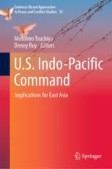Search
Search Results
-
Organization and History of the Unified Commands of the United States
The United States’ “Indo-Pacific Command” is a linchpin and carries great meaning not only militarily but also diplomatically. This chapter provides...
-
The Japan Self-Defense Forces and U.S. Indo-Pacific Command
Japan and the U.S. once viewed each other as enemies from across the Pacific Ocean, but the strong relationship of alliance constructed in the...
-
U.S. Indo-Pacific Command Implications for East Asia
The purpose of this book is to introduce readers to INDOPACOM, which is responsible for U.S. military operations in a region covering approximately...

-
The Korean Peninsula and Indo-Pacific Command
This chapter examines the role of INDOPACOM, which has become an increasingly important security actor on the Korean PeninsulaKorean peninsula in...
-
INDOPACOM and the Pentagon
The commander of INDOPACOM is often called the “second most powerful man in the world,” the first being the President of the United States. INDOPACOM...
-
Die USA und Asien
Nirgendwo sonst wird der internationale Führungsanspruch der Vereinigten Staaten von Amerika derzeit ähnlich stark herausgefordert wie in Asien. In...
-
The GSDF and Disaster Relief Dispatches
The damage caused by the Great East Japan Earthquake on March 11, 2011, was the greatest Japan has seen since World War II. To respond to this...
-
China’s Defense Against Post-unification Korea-US Alliance: Not at Yalu but Taiwan Strait
China has long upheld a neutral, if not opposing, stance to Korean unification, a stance which could be largely defined as the political risks...
-
Costs and Benefits of the U.S.-Japan Alliance from the Japanese Perspective
Since the end of the Cold War, the U.S.-Japan alliance has been transforming in its nature. Throughout the Cold War era, the Japanese government had...
-
Korea and the Japan-U.S. Alliance: A Japanese Perspective
Due to the geographical proximity and history, the Korean peninsula has traditionally been and continues to be one of the primary security interests...
-
Japanese Civil Society, NGOs, and Spatialized Politics: Mobilizing Public Opinion and the War in Iraq
Japan in the postwar period has won respect for its economic growth but not trust for its intentions. In nominal terms, Japan’s percentage of the...
-
Anti-American, pro-Chinese sentiment in South Korea
Anti-American, pro-Chinese sentiment is spreading widely in South Korea. This phenomenon is caused by extreme US-ROK policy dissension over matters...
-
The Japanese Perception of the Information Technology-Revolution in Military Affairs: Toward a Defensive Information-Based Transformation
In the early 1980s, a segment of the Soviet armed forces led by Marshal Nikolai Ogarkov predicted that the rapid development of computer systems and...
-
Japan’s Security Policy After US Hegemony
The ongoing debate on US hegemonic decline has far-reaching implications for US security relations with Japan. Some argue that both the sagging US...
